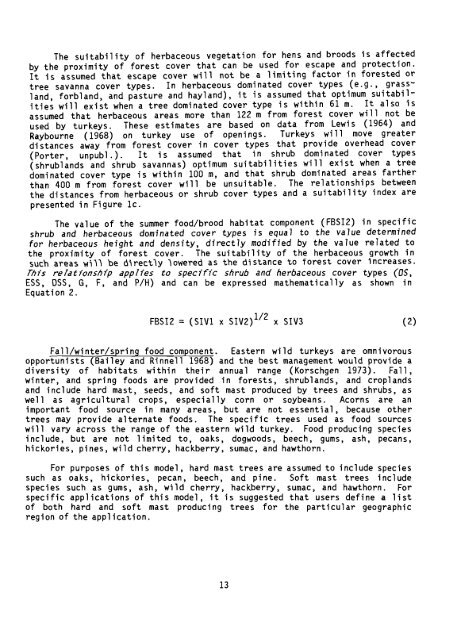habitat suitability index models: eastern wild turkey - USGS National ...
habitat suitability index models: eastern wild turkey - USGS National ...
habitat suitability index models: eastern wild turkey - USGS National ...
Create successful ePaper yourself
Turn your PDF publications into a flip-book with our unique Google optimized e-Paper software.
The <strong>suitability</strong> of herbaceous vegetation for hens and broods is affected<br />
by the proximity of forest cover that can be used for escape and protection.<br />
It is assumed that escape cover will not be a limiting factor in forested or<br />
tree savanna cover types. I n herbaceous domi nated cover types (e.g., grassland,<br />
forbland, and pasture and hayland), it is assumed that optimum suitabilities<br />
will exist when a tree dominated cover type is within 61 m. It also is<br />
assumed that herbaceous areas more than 122 m from forest cover wi 11 not be<br />
used by <strong>turkey</strong>s. These estimates are based on data from Lewis (1964) and<br />
Raybourne (1968) on <strong>turkey</strong> use of openings. Turkeys will move greater<br />
distances away from forest cover in cover types that provide overhead cover<br />
(Porter, unpubl.). It is assumed that in shrub dominated cover types<br />
(shrublands and shrub savannas) optimum suitabilities will exist when a tree<br />
dominated cover type is within 100 m, and that shrub dominated areas farther<br />
than 400 m from forest cover will be unsuitable. The relationships between<br />
the distances from herbaceous or shrub cover types and a <strong>suitability</strong> <strong>index</strong> are<br />
presented in Figure 1c.<br />
The value of the summer food/brood <strong>habitat</strong> component (FBSI2) in specific<br />
shrub and herbaceous dominated cover types is equal to the value determined<br />
for herbaceous height and density, directly modified by the value related to<br />
the proximity of forest cover. The <strong>suitability</strong> of the herbaceous growth in<br />
such areas will be directlY lowered as the distance to forest cover increases.<br />
Tllfs re!at fonsllfp applies to specific shrub end nerbeceous cover types (aS,<br />
ESS, DSS, G, F, and P/H) and can be expressed mathematically as shown in<br />
Equation 2.<br />
FBSI2 = (SIV1 x SIV2)1/2 x SIV3 ( 2)<br />
Fall/winter/spring food component. Eastern <strong>wild</strong> <strong>turkey</strong>s are omnivorous<br />
opportunists (Bailey and Rinnell 1968) and the best management would provide a<br />
diversity of <strong>habitat</strong>s within their annual range (Korschgen 1973). Fall,<br />
winter, and spring foods are provided in forests, shrublands, and croplands<br />
and include hard mast, seeds, and soft mast produced by trees and shrubs, as<br />
well as agricultural crops, especially corn or soybeans. Acorns are an<br />
important food source in many areas, but are not essential, because other<br />
trees may provide alternate foods. The specific trees used as food sources<br />
will vary across the range of the <strong>eastern</strong> <strong>wild</strong> <strong>turkey</strong>. Food producing species<br />
include, but are not limited to, oaks, dogwoods, beech, gums, ash, pecans,<br />
hickories, pines, <strong>wild</strong> cherry, hackberry, sumac, and hawthorn.<br />
For purposes of this model, hard mast trees are assumed to include species<br />
such as oaks, hickories, pecan, beech, and pine. Soft mast trees include<br />
species such as gums, ash, <strong>wild</strong> cherry, hackberry, sumac, and hawthorn. For<br />
specific applications of this model, it is suggested that users define a list<br />
of both hard and soft mast producing trees for the particular geographic<br />
region of the application.<br />
13

















